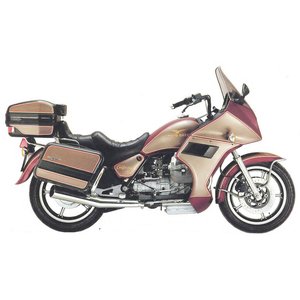Moto Guzzi California 1000 [1989–1994]: A Timeless Italian Cruiser with Character
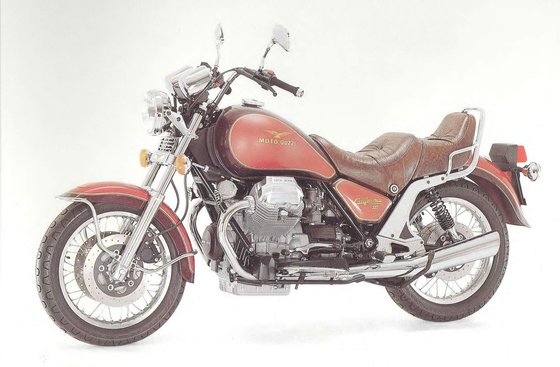
Introduction
The Moto Guzzi California 1000, produced from 1989 to 1994, is a motorcycle that defies easy categorization. Part cruiser, part touring machine, and entirely Italian, it’s a bike that prioritizes soul over stereotypes. With its longitudinally mounted V-twin engine, shaft drive, and distinctive styling, the California 1000 remains a cult classic—a machine that rewards riders who value mechanical personality and long-distance capability. After spending time with a well-preserved example from this era, it’s clear why this Guzzi still commands loyalty decades later.
Design & Styling
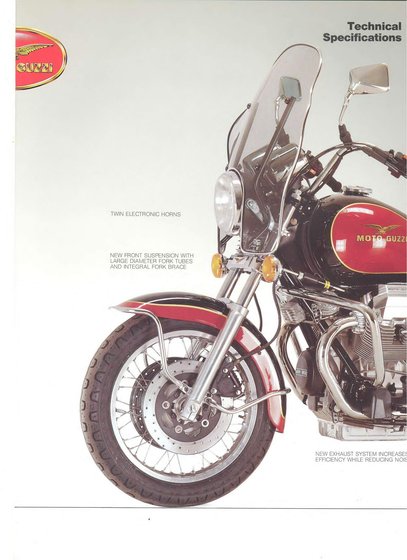
The California 1000’s design is a blend of function and understated elegance. Its defining feature is the 90-degree V-twin engine, mounted lengthwise with cylinders protruding proudly into the airstream. This layout isn’t just for show—it’s a hallmark of Moto Guzzi’s engineering identity, enabling efficient shaft drive integration. The teardrop fuel tank, chrome accents, and dual exhausts give it a classic cruiser silhouette, but with a European twist.
The 1990s-era models introduced fuel injection (Weber IAW ALFA-N system) on select variants, a forward-thinking feature at the time. The cockpit is utilitarian yet thoughtful, with a analog speedometer and tachometer flanking a simple indicator panel. The inclusion of a centerstand, chrome luggage rack, and optional hard bags (32–42 liters) underscores its touring intentions.
Engine & Performance
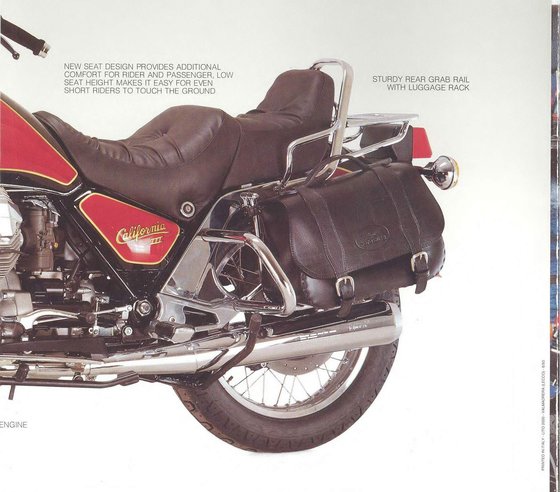
The Heartbeat of Italy
At the core of the California 1000 lies its air-cooled 949 cc V-twin, producing 65–71 HP (48–53 kW) and a robust 74.5–80 Nm (55–59 lb-ft) of torque. These numbers don’t scream “performance” by modern standards, but the engine’s character is its true selling point.
- Throttle Response: Fuel-injected models (marked “Injection”) deliver crisp, immediate response, even at low RPMs. Carbureted versions require a brief warm-up but settle into a smooth idle.
- Torque Delivery: Peak torque arrives as low as 3,000 RPM, making it effortless to lug the bike in higher gears. This is a motor built for relaxed cruising, not drag strips.
- Soundtrack: The exhaust note is a deep, throaty rumble—distinctly Italian, with a pulse that’s more symphonic than the Harley-Davidson’s bass-heavy growl.
Quirks & Charms
The Guzzi’s longitudinal crankshaft creates noticeable torque reaction. Blip the throttle at a standstill, and the bike leans slightly to the right—a quirk that becomes endearing rather than annoying. Vibration is present between 55–75 mph (89–121 km/h) in top gear, but downshifting to fourth smooths it out. Owners report vibrations diminish after the 5,000–10,000 km break-in period.
Handling & Ride Quality
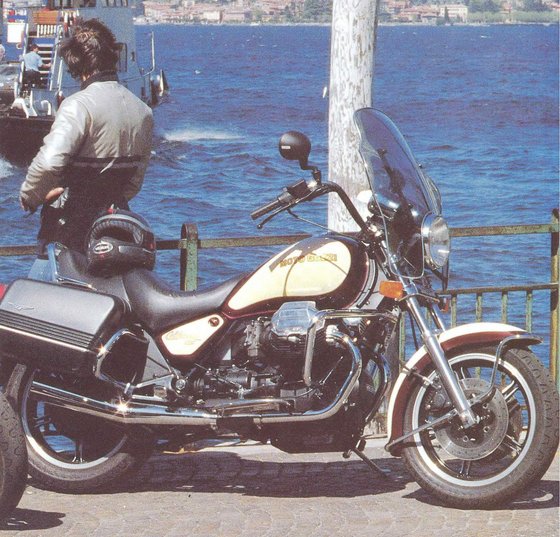
Chassis Dynamics
The California 1000’s tubular steel frame and suspension setup defy cruiser norms. With 18-inch wheels, a 40 mm telescopic fork, and adjustable Koni rear shocks (5-way preload), it handles twisties with unexpected poise. The shaft drive minimizes drivetrain lash, and the bike remains stable under hard acceleration or deceleration.
- Steering: Neutral and precise, with a 770 mm (30.3-inch) seat height inspiring confidence at low speeds.
- Brakes: Dual 300 mm front discs with Brembo calipers and a single 270 mm rear disc provide strong stopping power. The integrated braking system (rear pedal activates both brakes) takes getting used to but works seamlessly once mastered.
- Tires: Stock 110/90-18 (front) and 120/90-18 (rear) tires offer ample grip for spirited riding.
Ride Comfort
The suspension soaks up bumps admirably, and the riding position—upright with mid-mounted floorboards—is ideal for all-day rides. The stock seat, however, is a common pain point. Many owners upgrade to aftermarket options like Corbin saddles for marathon sessions.
Comfort & Practicality
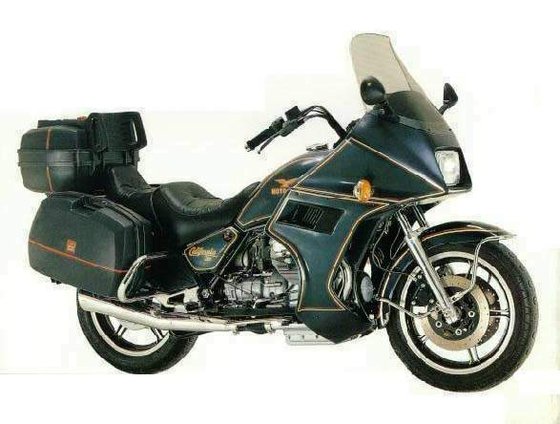
- Fuel Capacity: 25–26 liters (6.6–6.9 US gallons) grants a 320–400 km (200–250 mi) range, depending on riding style.
- Ergonomics: Floorboards and a slight pullback handlebar create a natural posture. Taller riders may find their knees brushing the cylinder heads.
- Luggage: Optional hard bags are weatherproof and lockable—a rarity in the 1990s.
Competition

In the early ’90s cruiser market, the California 1000 faced off against:
- Harley-Davidson Sportster 1200:
- Pros: Iconic branding, aftermarket support.
- Cons: Harsher ride, inferior handling.
-
Guzzi Edge: Shaft drive, superior suspension, and unique engine character.
-
Yamaha Virago 1100:
- Pros: Lighter weight, lower seat height.
- Cons: Chain drive, less torque.
-
Guzzi Edge: Build quality and touring capability.
-
BMW R 100 Cruiser:
- Pros: Boxer engine smoothness, reliability.
- Cons: Bland styling, higher cost.
- Guzzi Edge: More engaging ride, Italian flair.
The California 1000 carved a niche for riders seeking a cruiser that didn’t compromise on engineering—a bike that could handle mountain roads as deftly as highway miles.
Maintenance
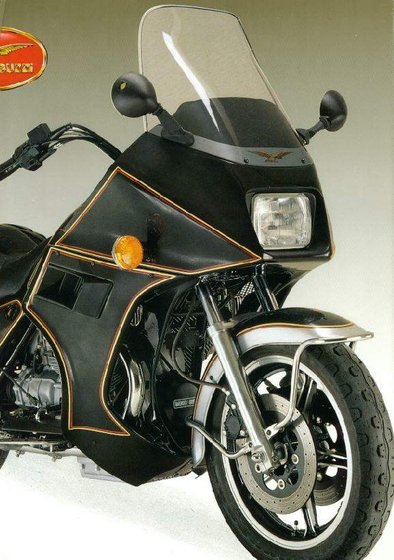
Key Considerations for Owners
1. Valve Adjustments:
- Requires checking every 10,000 km (6,200 mi).
- Cold valve clearance: 0.22 mm (0.0087 in) for both intake and exhaust.
- Oil & Fluids:
- Engine oil (SAE 10W-40 or 20W-40): 3.0 liters with filter changes.
- Gearbox oil (SAE 90W): 750 ml.
- Final drive oil (SAE 90W): 230 ml.
-
Brake fluid: DOT 4.
-
Tire Pressures:
- Front: 2.2–2.4 bar (32–35 psi).
-
Rear: 2.6–2.8 bar (38–41 psi).
-
Spark Plugs:
- NGK BP7ES or BPR7EIX (gap: 0.6 mm / 0.024 in).
Upgrades & Recommendations
- Exhaust: Aftermarket systems enhance the V-twin’s soundtrack without compromising torque.
- Suspension: Progressive-rate springs or modern shocks improve ride quality.
- Brakes: Brembo sintered pads for sharper stopping.
Final Thoughts
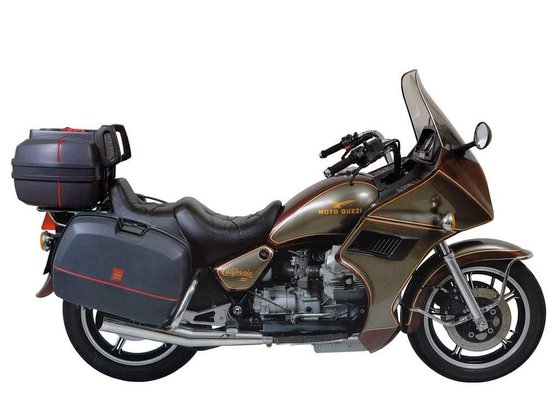
The Moto Guzzi California 1000 isn’t a bike for everyone—and that’s precisely its appeal. It’s a motorcycle that demands engagement, rewarding riders with a blend of mechanical charisma and long-legged competence. Whether you’re navigating cobblestone streets or carving through alpine passes, the California 1000 feels alive beneath you, a reminder of an era when motorcycles were as much about character as convenience.
For owners looking to preserve or enhance their California 1000, MOTOPARTS.store offers a curated selection of OEM-spec parts and performance upgrades, ensuring this Italian classic continues to turn heads and conquer miles for decades to come.
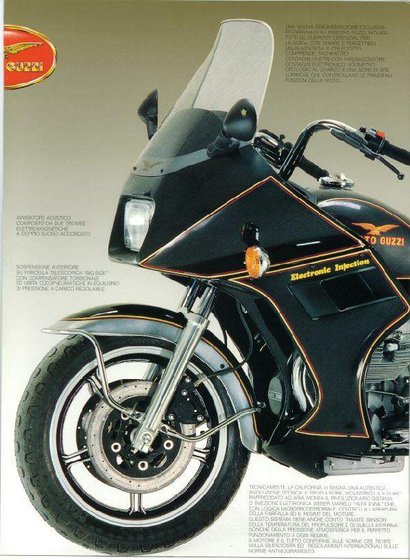

Specifications sheet
| Engine | |
|---|---|
| Stroke: | Four-stroke |
| Max power: | 71 kW | 95.0 hp |
| Max torque: | 80 Nm |
| Fuel system: | Digital electronic injection (Weber IAW ALFA-N) |
| Max power @: | 6800 rpm |
| Displacement: | 949 ccm |
| Max torque @: | 3000 rpm |
| Bore x stroke: | 88.0 x 78.0 mm (3.5 x 3.1 in) |
| Configuration: | V |
| Cooling system: | Air-cooled |
| Compression ratio: | 9.5:1 |
| Number of cylinders: | 2 |
| Valves per cylinder: | 2 |
| Dimensions | |
|---|---|
| Wheelbase: | 1555 mm (61.2 in) |
| Dry weight: | 250 |
| Wet weight: | 290 |
| Seat height: | 770 mm (30.3 in) |
| Fuel tank capacity: | 26 L (6.87 US gal) |
| Drivetrain | |
|---|---|
| Final drive: | shaft |
| Transmission: | 5-speed |
| Maintainance | |
|---|---|
| Rear tire: | 130/90-18 |
| Engine oil: | 10W40 |
| Front tire: | 110/90-18 |
| Break fluid: | DOT 4 |
| Spark plugs: | NGK BP7ES or NGK BPR7EIX |
| Spark plug gap: | 0.6 |
| Final drive oil: | SAE 90W |
| Transmission oil: | SAE 90W |
| Forks oil capacity: | 0.14 |
| Engine oil capacity: | 3.0 |
| Final drive oil capacity: | 0.23 |
| Transmission oil capacity: | 0.75 |
| Engine oil change interval: | Every 5000 km or 2 years |
| Valve clearance (intake, cold): | 0.22 mm |
| Valve clearance check interval: | 24,000 km / 15,000 mi |
| Valve clearance (exhaust, cold): | 0.22 mm |
| Recommended tire pressure (rear): | 2.4 bar (35 psi) solo, 2.8 bar (41 psi) with passenger |
| Recommended tire pressure (front): | 2.2 bar (32 psi) |



